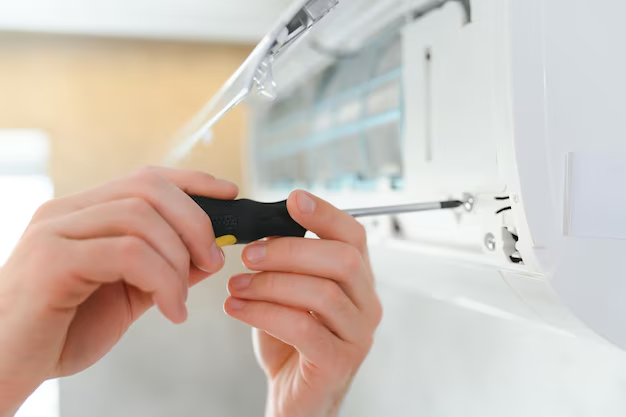How to Replace Your Samsung Refrigerator Filter for Fresh, Clean Water
Have you ever poured a glass of water from your refrigerator and wondered if it’s as clean as it should be? Ensuring the freshness and purity of your water is as simple as regularly replacing your refrigerator filter. If you own a Samsung refrigerator, you're in luck. Replacing the filter is relatively straightforward, and with the right guidance, it’s a task you can accomplish quickly. This guide will walk you through the process of installing a new Samsung refrigerator filter, empowering you with the knowledge to maintain your appliance efficiently.
🛠️ Getting Started: Understanding Your Filter System
Before diving into the steps of installation, it’s important to understand the type of filter your refrigerator uses. Samsung refrigerators usually use either an external filter or an internal filter. The external filters are typically mounted in a compartment separate from the refrigerator, whereas internal filters are found inside the fridge, often in the upper right or lower left corner.
Types of Samsung Filters
1. External Filter:
- Located outside the refrigerator.
- Often found in older models or those plumbed separately.
2. Internal Filter:
- Located inside the refrigerator compartment.
- Found in modern models, often near the top or bottom.
🔍 Step-by-Step Guide to Filter Installation
To ensure your refrigerator continues to supply you with clean water, you should replace the filter approximately every six months. Here's a breakdown of how to install your Samsung refrigerator filter:
📋 Preparation Steps
Check Your Model Number:
- Knowing your refrigerator model is crucial to purchasing the correct filter type. This information is typically found in your refrigerator's user manual or on a label inside the fridge door.
Purchase the Correct Filter:
- Purchase a certified Samsung filter or a compatible filter that matches your model specifications. This ensures efficiency and water quality.
Gather Necessary Tools:
- You generally won't need any special tools, but a small towel or cloth will come in handy to catch any water drips.
🧊 Installation Process for Internal Filters
Turn Off the Water Supply:
- Locate the water valve connected to your refrigerator and turn it off to prevent leaks.
Remove the Old Filter:
- Most internal filters have a twist-off mechanism. Grip the old filter and turn it counterclockwise until it comes loose.
Install the New Filter:
- Insert the new filter into the filter housing and twist it clockwise until it’s snug. You should feel a slight resistance when it’s properly seated.
Turn the Water Supply Back On:
- Slowly open the valve and check for leaks around the filter. If you notice any drips, ensure the filter is tight.
Flush the New Filter:
- Run several liters of water through the dispenser to flush out any air or loose carbon particles. This typically takes around 5 gallons.
🌐 Installation Process for External Filters
Turn Off the Water Supply:
- Shut off the valve supplying water to the refrigerator.
Remove the Old Filter:
- External filters often rely on quick-connect fittings. Press the ring around the connection point to release the filter.
Attach the New Filter:
- Insert the tubing into the new filter. It should fit snugly into the fittings without force.
Turn the Water Supply Back On:
- Open the valve and observe the connections for leaks. Tighten connections as needed to stop any drips.
Flush the Filter:
- As with internal filters, run about 5 gallons of water through the system to clear out air and impurities.
🔍 Additional Tips for Maintaining Your Samsung Refrigerator
To ensure the longevity and efficiency of your Samsung refrigerator, consider these extra maintenance tips.
🧼 Clean Regularly
- Clean the refrigerator's condenser coils every six months to maintain cooling efficiency.
- Wipe down door seals to ensure they maintain a tight seal, saving energy and keeping food fresh.
⚠️ Monitor Filter Life
- Most Samsung refrigerators have an indicator light that changes color or switches off when the filter needs replacing. Monitor this light to know when it’s time for a change.
📅 Maintain a Schedule
- Make it a habit to write down the filter installation date or set a calendar reminder every six months. This will help ensure that you never miss a filter replacement cycle.
📄 Table: Quick Steps to Replacing Your Samsung Refrigerator Filter
| Step | Internal Filter | External Filter |
|---|---|---|
| 1️⃣ | Turn off water supply | Turn off water supply |
| 2️⃣ | Remove old filter (twist-off) | Remove old filter (quick-connect) |
| 3️⃣ | Install new filter (twist-on) | Install new filter (insert tubing) |
| 4️⃣ | Turn water back on | Turn water back on |
| 5️⃣ | Flush 5 gallons of water | Flush 5 gallons of water |
💡 Key Takeaways for Refrigerator Maintenance
- Consistency is Key: Regular maintenance prevents large issues and ensures fresh-tasting water.
- Correct Filters Matter: Ensure you're always using the correct filter for your specific model to maintain efficiency and water quality.
- Timing is Essential: Replacing filters every six months is crucial to prevent clogs and ensure clean water.
Wrap-Up: Empower Your Household
Understanding the process and importance of installing Samsung refrigerator filters can empower you to maintain your appliance and ensure your family enjoys fresh and clean water every day. The task is simple, doesn't require tools, and can significantly enhance the function of your refrigerator. By committing to regular maintenance, you not only optimize the appliance’s performance but also invest in the health and well-being of everyone in your home. So grab your new filter, save this guide, and take the first step towards a more efficient home appliance system. Happy maintaining!
